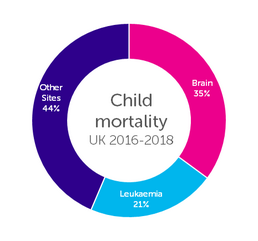Children's cancers mortality statistics
|
The most common causes of cancer death in children are malignant brain, other central nervous system (CNS) and intracranial tumours, followed by leukaemia.[1-3] Routinely-collected mortality data are presented by ICD-10 code. However, this coding framework is generally not appropriate for cancer in children because it defines tumours using body site rather than cell type, and the latter is more important for cancer in children. ICD-10 coding is considered reliable for malignant brain and other CNS tumours and leukaemias in children.[4] Finer breakdowns of deaths by cancer type are available but the data are not recent.[5] |
Children’s Cancers by Cancer Type, Average Number of Deaths per Year, Age 0-14, UK, 2016-2018 |
See also
Cancer mortality statistics for all cancers in the UK
References
- Data were provided by the Office for National Statistics on request, November 2019. Similar data can be found here: http://www.ons.gov.uk/peoplepopulationandcommunity/birthsdeathsandmarriages/deaths.
- Data were provided by Pubic Health Scotland on request, October 2019. Similar data can be found here.
- Data were provided by the Northern Ireland Cancer Registry on request, June 2020. Similar data can be found here.
- Public Health England. Childhood Cancer Mortality in the UK and Internationally, 2005-2010.
- Stiller C (Ed.) Childhood cancer in Britain: incidence, survival and mortality. Oxford University Press, 2007.
About this data
Data is for UK, 2016-2018, Brain ICD-10 C70-C72;Leukaemia ICD-10 C91-C95; Other cancers ICD-10 C00-C69, C73-C90, C96-C97, D32-D33, D35.2-D35.4, D42-D43, D44.3-D44.5; All cancers combined C00-C97, D32-D33, D35.2-D35.4, D42-D43, D44.3-D44.5.
Last reviewed: 1 February 2021
Cancer (excluding benign, uncertain and unknown behaviour brain, other CNS and intracranial tumours) is the leading cause of death for boys and girls aged 1-14. Cancer accounted for 23% of all deaths in this age group in 2021).[1-3]
See also
Find out more about the counting and coding of this data
Cancer mortality statistics by age
Cancer incidence by age statistics
Cancer survival by age statistics
References
- England and Wales data were from the Office for National Statistics, accessed December 2022: Nomis mortality statistics by underlying cause, sex and age.
- Scotland data were from the National Records of Scotland, accessed December 2022: https://www.publichealthscotland.scot/publications/
- Northern Ireland data were from the Northern Ireland Statistics and Research Agency, accessed December 2022: Registrar General Annual Report 2021 Cause of Death
About this data
Data is for UK, 2021, at ICD-10 chapter level for ICD-10 A00-R99, V01-Y98 and U00-U85, except for ICD-10 C00-D48 (neoplasms) which is split into C00-C97 (malignant neoplasms) and D00-D48 (in situ and benign neoplasms, and neoplasms of uncertain or unknown behaviour).
Last reviewed: 19 July 2023
An estimated 17,700 children’s cancer deaths had been avoided in the UK by 2018 because mortality rates have fallen since the 1970s.[1]
See also
Cancer incidence statistics for children's cancers in the UK
References
- Calculated by the Cancer Intelligence Team at Cancer Research UK, 2021, based on method set out in Siegel R, Ward E, Brawley O, Jemal A., Cancer statistics, 2011: the impact of eliminating socioeconomic and racial disparities on premature cancer deaths. CA Cancer J Clin. 2011 Jul-Aug;61(4):212-36.
About this data
Data is for UK, 1971-2018, ICD-10 C00-C97, D32-D33, D35.2-D35.4, D42-D43, D44.3-D44.5.
The number of avoided cancer deaths is estimated by comparing the actual number of cancer deaths observed, with number of cancer deaths expected if mortality rates had not fallen from their observed peak. The number of cancer deaths expected is calculated by applying the cancer mortality rate in the overall peak year, to the total population in each subsequent year. These calculations are made for males and females separately in each five-year age band (e.g. using age-specific mortality rates for the overall peak year), and summed to create the UK total.
Last reviewed: 1 September 2021
Statistics by cancer type
View our latest cancer statistics including key stats, in-depth explanations and raw data on cancer incidence, mortality, survival, risk, and diagnosis and treatment.
Citation
You are welcome to reuse this Cancer Research UK content for your own work.
Credit us as authors by referencing Cancer Research UK as the primary source. Suggested styles are:
Web content: Cancer Research UK, full URL of the page, Accessed [month] [year].
Publications: Cancer Research UK ([year of publication]), Name of publication, Cancer Research UK.
Graphics (when reused unaltered): Credit: Cancer Research UK.
Graphics (when recreated with differences): Based on a graphic created by Cancer Research UK.
When Cancer Research UK material is used for commercial reasons, we encourage a donation to our life-saving research.
Send a cheque payable to Cancer Research UK to: Cancer Research UK, 2 Redman Place, London, E20 1JQ or
Newsletter
Stay up to date by signing up to our cancer statistics and intelligence newsletter
Acknowledgements
We are grateful to the many organisations across the UK which collect, analyse, and share the data which we use, and to the patients and public who consent for their data to be used. Find out more about the sources which are essential for our statistics.

